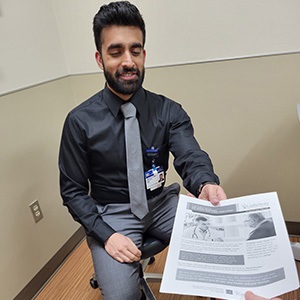
By Mohammad Umar Ahmed, MD
A 56-year-old Caucasian man with hypertension and diabetes presented to the ED with progressively worsening dyspnea, orthopnea, and bilateral lower extremity edema; his ECG demonstrated atrial fibrillation with rapid ventricular response. He resides independently at home, but a neighbor – and good friend – accompanied him in the hospital room. His calm demeanor and stoic features reflected his awareness of the gravity of the situation. His health conditions were largely well-controlled, and he had few complaints. Until now. Once he was stabilized and was getting settled for the night, I was able to bring him the "AFib and High Risk for Stroke decision aid" for our discussion. With the help of the decision aid, I was able to explain atrial fibrillation, describe the implications, and have a meaningful discussion regarding stroke and bleeding risk. As we talked, a furrowing of his brow conveyed critical appraisal. He asked few questions but paid close attention to the infographics and statistics. At the conclusion of our conversation, his furrowed brow had fewer wrinkles. He asked to keep the packet overnight to continue to refer to its contents. At our follow-up discussion, we agreed to initiate prophylactic anticoagulation.
A 30-year-old Black man with no known health issues in his past medical history arrived at his initial clinic appointment to discuss a recent episode of palpitations a few weeks prior. He described the incident as a harrowing experience, precipitated by modest physical activity while helping a friend move. The sudden onset of palpitations made it difficult to draw in deep breaths and caused a vague, indescribable chest pain. The episode resolved after 30 minutes and only has occurred intermittently since with milder symptoms. His ECG in the clinic showed atrial fibrillation. Using the decision aid, we discussed the etiology of the condition, modulation of risk factors, and stroke versus bleeding risks. As we talked, his confusion and frustration with the development of this condition improved with the understanding of the disease process and management options. He asked to take the decision aid home with him and together we agreed upon a plan to utilize a patch monitor for a brief period of time. When he returned to clinic, notations on his decision aid reflected the time he had spent reviewing this information. His patch monitor showed atrial fibrillation and he agreed with a strategy to initiate anticoagulation with plans for ablation.
A 76-year-old Hispanic man with a history of hypertension, diabetes, and heart failure arrived in the ED due to abrupt onset right upper and lower extremity weakness and was diagnosed with acute ischemic stroke. His ECG showed atrial fibrillation. After his acute stroke management, I was able to speak with him regarding his new atrial arrhythmia. The decision aid was especially useful, as it helped shed light on the etiology of the condition that had caused him pain and fear. The infographics and discussion of annual stroke risk were especially helpful. Although we both knew that he still had a lengthy road to recovery, the discussion that we had regarding his atrial fibrillation helped shed some light during a dark time of his life. We eventually pursued anticoagulation once it was safe to do so.
Discussion
The atrial fibrillation decision aid is an effective informational tool that fosters healthy discussion between a physician and patient, as witnessed in the above midwestern patient interactions. The information provided in the decision aid is concise and employs both infographics and statistics, both of which are central to patients’ understanding of the disease. Because it is all encompassing, it can take up to 15-20 minutes to review in its entirety with patients – a manageable feat in both the inpatient and outpatient settings. One of the possible downsides of the decision aid is the sensation of information overload that some patients may get – it is a five-page document after all. However, if reviewed appropriately and patients are encouraged to reference it over time, it can be a very valuable tool.
Overall, the decision aid is an effective method for fostering discussion, enhancing the patient-physician relationship, and educating patients on their newly diagnosed condition by emphasizing the ACGME competency of interpersonal and communication skills. The three cases above demonstrate that regardless of age, gender, ethnicity, and background, the human needs in the setting of new health issues are similar: information, guidance, and effective communication.
Mohammad Umar Ahmed, MD, is a cardiovascular disease fellow at Corewell Health West Frederik Meijer Heart & Vascular Institute in Grand Rapids, MI.